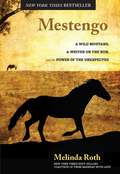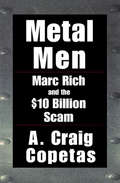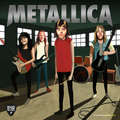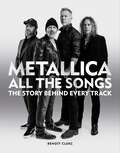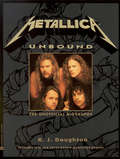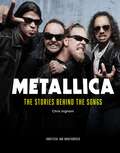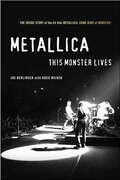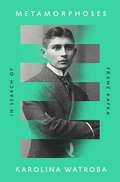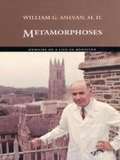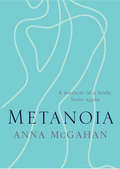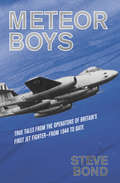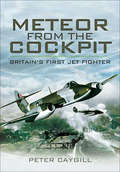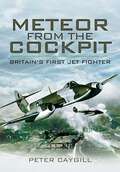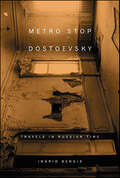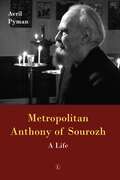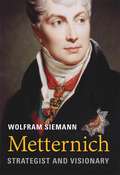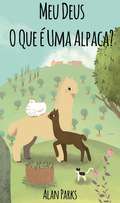- Table View
- List View
Mestengo: A Wild Mustang, a Writer on the Run, and the Power of the Unexpected
by Melinda RothExhausted by her job as a political press secretary, Melinda Roth found the courage to escape. Her goal: a simpler life in rural Illinois that would let her pursue her passion for writing. But then real life intervened. A fire at a neighboring farm and a misinterpreted gesture of kindness transformed her into the reluctant caretaker of a homeless menagerie of animals. Roth, coauthor of the New York Times-bestseller From Baghdad with Love, writes vividly, movingly, and often humorously of the chaos that descended into her life. One of her new tenants was a wild mustang, broken but not bowed, his restless spirit propelling him to escape the fences and pens that enclosed him—a far different life than before he was violently captured by a government-sponsored &“round-up.&” Ultimately these two fiercely independent characters each provide the catalyst for the other&’s life-changing and life-affirming decisions.Mestengo is a captivating, emotional account that taps into readers&’ love of animals: Marley and Me meets The Horse Whisperer. An entertaining and delightful read, it is a cinematic, sometimes tense, but always beautiful story of the power of healing.
Metal Men: Marc Rich and the $10 Billion Scam
by A. Craig CopetasThis true story of the multibillionaire who fled to Switzerland &“reads like a mystery novel&” (USA Today). How did Marc Rich make over ten billion dollars while paying hardly any taxes? Journalist A. Craig Copetas infiltrated the inner circle of the commodities market and Rich&’s associates to show not only how the metals and minerals trader pulled off the scam, becoming one of America&’s most wanted criminals, but also how other traders have used the same model to evade taxes as well. A continuing figure of controversy even after his death, Rich, a hedge fund manager and the founder of Glencore, was wanted for evading almost ninety million dollars in taxes and if caught, could have spent life in prison. From a former staff reporter at The Wall Street Journal, Metal Men is a story of international intrigue spanning the globe, from the inside of the White House to the Kremlin, a brilliantly researched work that exposes the inner workings of one of country&’s largest scams. &“Mr. Copetas is at his best evoking the high-stakes, fast-paced life of the commodities traders: the greed and corruption that consume them are the stuff of high drama.&” —The New York Times Book Review
Metallica (Band Records #2)
by Soledad Romero Mariño David NavasLa historia de METALLICA, el legendario grupo de Thrash Metal, explicada a los más pequeños. La fascinante historia de Metallica empieza en Los Ángeles, cuando Lars Ulrich, una promesa del tenis mundial, abandona su carrera para montar una banda Metal y convertirse en el mejor baterista del mundo. Cuando puso un anuncio en una revista para encontrar compañeros de banda interesados en los sonidos de Motorhëad e Iron Maiden, apareció James Hetfield, guitarrista y cantante con alguna experiencia en otros grupos. Al poco se les unieron Dave Mustain y Cliff Burton para completar la formación y conquistar el feroz mundo del Metal. Metallica es un cuento que derrocha los valores que el Rock ha dejado a toda una generación: libertad, coraje, independencia y lealtad a uno mismo.
Metallica (Band Records #Volumen)
by David Navas Soledad Romero MariñoLa historia de METALLICA, el legendario grupo de Thrash Metal, explicada a los más pequeños. La fascinante historia de Metallica empieza en Los Ángeles, cuando Lars Ulrich, una promesa del tenis mundial, abandona su carrera para montar una banda Metal y convertirse en el mejor baterista del mundo. Cuando puso un anuncio en una revista para encontrar compañeros de banda interesados en los sonidos de Motorhëad e Iron Maiden, apareció James Hetfield, guitarrista y cantante con alguna experiencia en otros grupos. Al poco se les unieron Dave Mustain y Cliff Burton para completar la formación y conquistar el feroz mundo del Metal. Metallica es un cuento que derrocha los valores que el Rock ha dejado a toda una generación: libertad, coraje, independencia y lealtad a uno mismo.
Metallica All the Songs
by Benoît ClercThis is the most in-depth exploration of Metallica's songs ever written.From their widely circulated demo, No Life 'til Leather, all the way to their 10th studio album Hardwired... to Self-Destruct - Metallica have earned the title of the biggest heavy metal band on the planet. Their albums, including the hugely influential Master of Puppets, are now considered classics of rock and metal, while singles such as Enter Sandman, Fade to Black and For Whom the Bell Tolls have stood the test of time. Follow the epic journey of the godfathers of thrash metal, song-by-song, and see how they became one of the biggest selling bands in the world.No stone is left unturned across more than 500 pages, illustrated with incredible photography throughout, from the inspiration behind the lyrics and melodies to the recording process and even the musicians and producers who worked on each track.Uncover the stories behind the music in this truly definitive book - a must-have for every Metallica fan.
Metallica All the Songs
by Benoît ClercThis is the most in-depth exploration of Metallica's songs ever written.From their widely circulated demo, No Life 'til Leather, all the way to their 10th studio album Hardwired... to Self-Destruct - Metallica have earned the title of the biggest heavy metal band on the planet. Their albums, including the hugely influential Master of Puppets, are now considered classics of rock and metal, while singles such as Enter Sandman, Fade to Black and For Whom the Bell Tolls have stood the test of time. Follow the epic journey of the godfathers of thrash metal, song-by-song, and see how they became one of the biggest selling bands in the world.No stone is left unturned across more than 500 pages, illustrated with incredible photography throughout, from the inspiration behind the lyrics and melodies to the recording process and even the musicians and producers who worked on each track.Uncover the stories behind the music in this truly definitive book - a must-have for every Metallica fan.
Metallica Unbound
by K. J. DoughtonWritten by a noted hard rock journalist who has covered the band since its inception 10 years before the book was published, this one-of-a-kind, full-color collectors' volume provides the most in-depth information on the band available anywhere. Rare and never-before-published photos. Complete discography.
Metallica: The Stories Behind the Songs
by Chris InghamA deep dive into the music and songwriting of the world's greatest heavy metal band: Metallica.A must-read for any metalhead, Metallica: The Stories Behind the Songs breaks down the writing and recording of every track from each of the band's studio albums, including classic records such as Master of Puppets (1986) and Metallica ('The Black Album') (1991), right through to 2023's 72 Seasons.Written by former Metal Hammer publisher Chris Ingham and Illustrated with hundreds of stunning photos spanning more than 40 years, this updated entry in the bestselling Stories Behind the Songs series explores the influences behind more than 100 of the band's most celebrated tracks, offering fans a unique perspective into the creation, evolution and performance of their favourite songs.Packed with insight and analysis, this is a revealing guide to Metallica's discography from a true authority on the band, and an essential read for any fan.
Metallica: The Stories Behind the Songs (Stories Behind the Songs)
by Chris InghamA deep dive into the music and songwriting of the world's greatest heavy metal band: Metallica.A must-read for any metalhead, Metallica: The Stories Behind the Songs breaks down the writing and recording of every track from each of the band's studio albums, including classic records such as Master of Puppets (1986) and Metallica ('The Black Album') (1991), right through to 2023's 72 Seasons.Written by former Metal Hammer publisher Chris Ingham and Illustrated with hundreds of stunning photos spanning more than 40 years, this updated entry in the bestselling Stories Behind the Songs series explores the influences behind more than 100 of the band's most celebrated tracks, offering fans a unique perspective into the creation, evolution and performance of their favourite songs.Packed with insight and analysis, this is a revealing guide to Metallica's discography from a true authority on the band, and an essential read for any fan.
Metallica: This Monster Lives
by Greg Milner Joe Berlinger“Triumphs because of the commitment and fearlessness of Metallica . . . [and] shows that tenacious reporting can still produce great narratives.” —New York TimesMetallica is one of the most successful hard-rock bands of all time, having sold more than ninety million albums worldwide. Receiving unfettered access, acclaimed filmmakers Joe Berlinger and Bruce Sinofsky followed Metallica over two and a half years as they faced personal and professional challenges that threatened to destroy the band just as they returned to the studio to record their first album in four years. While the documentary itself provides an insider’s view of Metallica, the two and a half years of production (and more than 1,600 hours of footage) garnered far more than can be expressed in a two-hour film.Berlinger’s book reveals the stories behind the film, capturing the uncertainty, and ultimate triumph of both the filming and Metallica’s bid for survival. It weaves the on-screen stories together with what happened off-screen, offering intimate details of the band’s struggle amidst personnel changes, addiction, and controversy. In part because Berlinger was one of the only witnesses to the intensive group-therapy sessions and numerous band meetings, his account is the most honest and deeply probing book about Metallica—or any rock band—ever written.“A fascinating look at the logistics of making an album and the dysfunctional family that bands can become.” —Chicago Tribune“This book should be required reading for aspiring filmmakers.” —Publishers Weekly“Berlinger takes us even deeper into the inner sanctum. . . . many events that were edited for the film, including a pivotal scene in which drummer Lars Ulrich laces into singer James Hetfield, are transcribed in full.” —USA Today
Metamorphoses
by Rolfe Humphries OvidStories of passion, death, and transformation. From the introduction: "the great collection, the definitive compendium of ancient mythology, which is known to us as the Metamorphoses, or the Stories of Changing Forms. The work on which Ovid's reputation was founded shows a great deal of the spirit of the Restoration; unhappily for this happy man, there was in Augustus a great deal of the spirit of Cromwell. And from the official point of view, Ovid must often have seemed mischievous, if not downright subversive." [This text is listed as an example that meets Common Core Standards in English language arts in grades 9-10 at http://www.corestandards.org.]
Metamorphoses: In Search of Franz Kafka
by Karolina Watroba'A high-spirited, richly informed, and original portrait, a cross between biography, literary analysis and a study in modern canonisation: Karolina Watroba is an inspired guide and her book a pleasure to read.' Marina WarnerIn 2024, exactly one hundred years after his death at the age of 40, readers all over the world will reach for the works of Franz Kafka. Many of them will want to learn more about the enigmatic man behind the classic books filled with mysterious courts and monstrous insects. Who, exactly, was Franz Kafka?Karolina Watroba, the first Germanist ever elected as a Fellow of Oxford's All Souls College, will tell Kafka's story beyond the boundaries of language, time and space, travelling from the Prague of Kafka's birth through the work of contemporary writers in East Asia, whose award-winning novels are in part homages to the great man himself.Metamorphoses is a non-chronological journey through Kafka's life, drawing together literary scholarship with the responses of his readers through time. It is a both an exploration of Kafka's life and an exciting new way of approaching literary history.
Metamorphoses: In Search of Franz Kafka
by Karolina WatrobaThis groundbreaking study of Franz Kafka&’s legacy—to be published during the centenary of his death in 2024—explores Kafka&’s life and influence in an entirely new and dynamic way.In 2024, exactly one hundred years after his death at the age of forty, readers all over the world will reach for the works of Franz Kafka. Many of them will want to learn more about the enigmatic man behind the classic books filled with mysterious courts and monstrous insects. Who, exactly, was Franz Kafka? Karolina Watroba, the first Germanist ever elected as a fellow of Oxford's All Souls College, will tell Kafka's story beyond the boundaries of language, time, and space, traveling from the Prague of Kafka's birth through the work of contemporary writers in East Asia, whose award-winning novels are, in part, homages to the great man himself. Metamorphoses presents a non-chronological journey through Kafka's life, combining literary scholarship with the responses of his readers throughout the last century. It is a both an exploration of Kafka's life and an exciting new way of approaching literary history.
Metamorphoses: Memoirs of a Life in Medicine
by William G. AnlyanWilliam G. Anlyan, a dedicated doctor and gifted administrator, was a leader in the transformation of Duke University Hospital from a regional medical center into one of America's foremost biomedical research and educational institutions. Anlyan's fifty-five-year career at Duke University spanned a period of extraordinary change in the practice of medicine. He chronicles those transformations--and his role in them--in this forthright memoir.Born in Alexandria, Egypt, in 1925, and schooled in the British tradition, Anlyan attended Yale University as an undergraduate and medical student before coming to the relatively unknown medical school at Duke University in 1949 for an internship in general and thoracic surgery. He stayed on, first as a resident, then as a staff surgeon. By 1961, he was a full professor of surgery. In 1964, Anlyan was named dean of the medical school, the first in a series of administrative posts at the medical school and hospital. Anlyan's role in the transformation of the Duke University Medical Center into an internationally renowned health system is manifest: he restructured the medical school and hospital and supervised the addition of almost four million square feet of new or renovated space. He hired outstanding administrators and directed a staff that instituted innovative programs and groundbreaking research centers, such as the Cancer Center and the Physician's Assistant Program.Anlyan describes a series of metamorphoses in his own life, in the world of medicine, in Durham, and at Duke. At the time of his prep school upbringing in Egypt, medicine was a matter of controlling infectious diseases like tuberculosis and polio. As he became an immigrant medical student and then a young surgeon, he observed vast advances in medical practice and changes in the financing of medical care. During his tenure at Duke, Durham was transformed from a sleepy mill and tobacco town into the "City of Medicine," a place where patients routinely travel for open-heart surgery and cutting-edge treatments for cancer and other diseases.Anyone interested in health care, medical education, and the history of Duke University will find Anlyan's memoir of interest.
Metamorphosis: Who We Become after Facial Paralysis
by Faye Linda WachsLosing her smile to synkinesis after unresolved Bell’s palsy changed how Faye Linda Wachs was seen by others and her internal experience of self. In Metamorphosis, interviewing over one hundred people with acquired facial difference challenged her presumptions about identity, disability, and lived experience. Participants described microaggressions, internalizations, and minimalizations and their impact on identity. Heartbreakingly, synkinesis disrupts the ability to have shared moments. When one experiences spontaneous emotion, wrong nerves trigger misfeel and misperception by others. One is misread by others and receives confusing internal information. Communication of and to the self is irrevocably damaged. Wachs describes the experience as a social disability. People found a host of creative ways to reinvigorate their sense of self and self-expression. Like so many she interviewed, Wachs experiences a process of change and growth as she is challenged to think more deeply about ableism, identity, and who she wants to be.
Metanoia: A Memoir of a Body, Born Again
by Anna McGahanPerhaps we have done to our bodies what we have so long done to God?We have demanded they conform to the image we find the most desirable.We have treated them as rubbish bins, weapons and punching bags.We have muted their wills until their voices have fallen silent.At 23, Anna McGahan was wrestling with the rest of the world for ownership of her femininity, sexuality and physicality. As a young actor thrust into the spotlight as a poster girl for sexual liberation – intent on exploring the next relationship, the lowest weight and the wildest high – her path pointed her to chaos, starvation and isolation.Until – unexpectedly – she met God.In this memoir, Anna shares the story of reconciling with her body, mapping its journey from another product in a marketplace, to a vessel of inherent power and worth.Metanoia is the cry of a body broken and resurrected, the song of a bird set free.
Metaphors in International Relations Theory
by Michael P. MarksMetaphors constitute a fundamental way in which humans understand the world around them. This book offers a comprehensive analysis of metaphors in theories of international relations. Until recently, conscious attention to metaphors in theories of international relations has been haphazard and sporadic. This book examines the metaphors that inform the major paradigms in international relations theory. Readers will discover that the vast majority of the terminology cataloguing, defining, and naming theories, concepts, and analytical tools pertaining to the study of international relations are metaphorical in nature. The book concludes that metaphors are an essential element in all aspects of international relations theory.
Meteor Boys: True Tales from the Operators of Britain's First Jet Fighter–From 1944 To Date
by Steve BondThrough the first-hand experiences of pilots and ground crew, the author of Javelin Boys chronicles the history of the RAF’s first jet-engined aircraft. As Britain’s first jet fighter, the Gloster Meteor has had a remarkably varied and lengthy life. But while many books have focused on its development and service history, the time has come to hear the personal experiences of its air and ground crews. By interviewing over thirty veterans, author and Meteor veteran Steve Bond has written an incredibly detailed insight into this iconic aircraft, which is supported by anecdotes and accounts from those who knew it best. One example is Alan McDonald who described the Meteor as “a bit unforgiving if you got it wrong, as many pilots found out to their cost, especially on one engine, but I must admit I got to like it very much—it was a great adrenaline rush.” Alongside these entertaining anecdotes are details of the Meteor’s origins and developments. Starting with the first deliveries in 1944 working through to the present day, Bond documents the diverse role that the Meteor has had—from operations against the V1 and photo-reconnaissance missions to its use as a training machine and later as a display aircraft. The book also features photographs never seen before in print. This detailed history of this iconic and much loved jet fighter will appeal to all aviation fans. “Bond has done a great job with this book with many personal accounts of the people that were involved every day in the life of the Meteor. Highly Recommended.” —International Plastic Modelers’ Society/USA
Meteor from the Cockpit: Britain's First Jet Fighter
by Peter CaygillAn in-depth look at this historic military aircraft, including firsthand accounts from those who flew it. The Meteor is remembered as the first British jet fighter to enter squadron service and the only jet-powered Allied fighter to see action in WW II. Subsequent development was limited as a result of its relatively conventional airframe—although it did hold the world air speed record for a while. The Meteor was immensely strong and many pilots owe their lives to its rugged construction. For a whole generation of pilots, the aircraft—the Meatbox, as it was affectionately known—provided the ideal introduction to jet-powered flight. It did suffer a high accident rate, but many of the losses were due to lack of knowledge of the stresses of high-speed flight at low level and a misguided training program. Long after its first flight the Meteor lives on, as it is still used by Martin Baker to test ejection seats, testimony to the basic soundness of the design. This book looks into the aircraft&’s design history and development through many different variants—and includes many firsthand accounts of flying the aircraft in peace and war.
Meteor from the Cockpit: Britain's First Jet Fighter
by Peter CaygillAn in-depth look at this historic military aircraft, including firsthand accounts from those who flew it. The Meteor is remembered as the first British jet fighter to enter squadron service and the only jet-powered Allied fighter to see action in WW II. Subsequent development was limited as a result of its relatively conventional airframe—although it did hold the world air speed record for a while. The Meteor was immensely strong and many pilots owe their lives to its rugged construction. For a whole generation of pilots, the aircraft—the Meatbox, as it was affectionately known—provided the ideal introduction to jet-powered flight. It did suffer a high accident rate, but many of the losses were due to lack of knowledge of the stresses of high-speed flight at low level and a misguided training program. Long after its first flight the Meteor lives on, as it is still used by Martin Baker to test ejection seats, testimony to the basic soundness of the design. This book looks into the aircraft&’s design history and development through many different variants—and includes many firsthand accounts of flying the aircraft in peace and war.
Metro Stop Dostoevsky: Travels in Russian Time
by Ingrid BengisA Russian American writer catapults herself into the maelstrom of Russian life at a time of seismic change for bothThe daughter of Russian émigrés, Ingrid Bengis grew up wondering whether she was American or, deep down, "really Russian." In 1991, naïvely in love with Russia and Russian literature, she settled in St. Petersburg, where she was quickly immersed in "catastroika," a period of immense turmoil that mirrored her own increasingly complex and contradictory experience. Bengis's account of her involvement with Russia is heightened by her involvement with B, a Russian whose collapsing marriage, paralleling the collapse of the Soviet Union, produces a situation in which "anything could happen." Their relationship reflects the social tumult, as well as the sometimes dangerous consequences of American "good intentions." As Bengis takes part in Russian life-becoming a reluctant entrepreneur, undergoing surgery in a St. Petersburg hospital, descending into a coal mine-she becomes increasingly aware of its Dostoevskian duality, never more so than when she meets the impoverished, importuning great-great-granddaughter of the writer himself. Beneath the seismic shifting remains a centuries-old preoccuption with "the big questions": tradition and progress, destiny and activism, skepticism and faith. With its elaborate pattern of digression and its eye for the revealing detail, Bengis's account has the hypnotic intimacy of a late-night conversation in a Russian kitchen, where such questions are perpetually being asked.
Metropolitan Anthony of Sourozh: A Life
by Avril PymanAndrei Bloom (1914-2003) better known as Anthony Bloom, or Metropolitan Anthony of Sourozh, led an extraordinary life. He was an individual who sought to be in touch with his God yet in solidarity with and responsibility for a tragically disconnected society; a man of God who knew the world. From the difficulties of Russian emigre life that conditioned him as a monk without a monastery, through the trials and suffering of war and revolution, to his calling as Priest and Bishop of the Russian Orthodox Church in Great Britain, he moved between many changing landscapes, striving always to take his bearings in prayer and contemplation. In spite of the collapse of their whole way of life, his parents brought him up to be a generous and courteous friend to those around him. As a surgeon and doctor in German-occupied France, he would provide treatment to those in need irrespective of ethnic or ideological affiliation. In his character, joy in the good and the beautiful was compounded with ardor and tragic depths. This biography explores how Metropolitan Anthony sought the mind of Christ to cultivate and control his own loving heart and occasionally harsh exigence. Avril Pyman draws on a mosaic of available evidence to offer deeper insight into the life and times of a remarkable spiritual teacher, charismatic speaker and priest whose cosmopolitan background, character and experience of science and medicine made a unique and significant contribution to Orthodox Christian thought and practice throughout the world.
Metternich and the Duchess
by Dorothy Gies McguiganThe life of the leader most responsible for the defeat of Napoleon's endeavors.
Metternich: Strategist and Visionary (Beck'sche Reihe - Band 2484 Ser.)
by Wolfram SiemannWolfram Siemann tells a new story of Clemens von Metternich, the Austrian at the center of nineteenth-century European diplomacy. Known as a conservative and an uncompromising practitioner of realpolitik, in fact Metternich accommodated new ideas of liberalism and nationalism insofar as they served the goal of peace. And he promoted reform at home.
Meu Deus, O Que é Uma Alpaca?
by Fabiana Rodrigues Castelo Branco Alan ParksWould you risk everything for a new life? Would you give up and go home if it all went wrong? 'Meu Deus, O Que é uma Alpaca?' é uma estória franca e encantadora de um bravo casal que se muda para a Espanha para criar alpacas. Sua intenção é ganhar a vida, mas primeiro eles devem negociar seu caminho através do mercado imobiliário espanhol, personagens locais, construtores desonestos e o pior clima que Andaluzia tem visto por 100 anos. Alan e Lorna experimentam a alegria, mas também o desgosto de se criar alpacas, recolhendo uma variedade de animais perdidos pelo caminho. Eles serão bem sucedidos, ou os desafios serão demais para suportar? "uma leitura encantadora" "ri alto com regularidade" "Eu recomendaria este livro para qualquer um"
